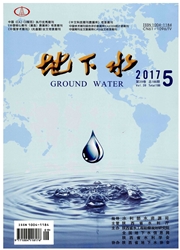

 中文摘要:
中文摘要:
渗透系数场的空间变异性是影响污染物运移结果的决定因素,而地质统计方法是解决渗透系数空间变异性的主要技术手段。本文利用野外场地实测数据,采用普通克里格法和指示克里格法、顺序高斯模拟法和顺序指示模拟法四种地质统计方法,插值估测和模拟再现随机渗透系数场,进而对比研究四种渗透系数场对大尺度污染物运移的影响。研究结果表明,污染羽的质心位置(一阶矩)主要由渗透系数的平均值来决定;污染羽在空间上的展布范围(二阶矩)主要受渗透系数空间变异方差的影响;条件模拟克服了估计法的平滑效果,较好地再现真实曲线的波动性,渗透系数( lnK)估计方差与污染羽空间二阶矩随着条件模拟次数的增加而减小,并且顺序指示模拟程度更加明显。
 英文摘要:
英文摘要:
The spatial variation of hydraulic conductivity distribution is the determining factor of groundwater contaminant transport and geostatistics is the main technique to slove the problem. Processing field data of an aquifer with four geostatistical techniques, including ordinary kriging method, indicator kriging method, sequential Gaussian simulation and sequence indica-tor simulation, hydraulic conductivity distribution of a pointed aquifer is mapped respectively to compare the influence of four simulation techniques on groundwater contaminant movement. Results indicate that the centroid of contaminant plume ( first movement) is positioned according to the average of hydraulic conductivity; the distribution range of contaminant plume ( sec-ond movement) is mainly affected by the variance of spatial variation of hydraulic conductivity. Condition simulation irons flaws raised by smoothing effect of estimation and reproduces the volatility of curve draw by real statistics. With repeated condi-tion simulations, estimated variance of lnK and the second movement of contaminant plum decrease and sequence indication simulation is more accurate.
 同期刊论文项目
同期刊论文项目
 同项目期刊论文
同项目期刊论文
 Fractionation and health risks of atmospheric particle-bound As and heavy metals in summer and winte
Fractionation and health risks of atmospheric particle-bound As and heavy metals in summer and winte The effects of aluminum stress on bacterial community diversity in acidic red soils by polymerase ch
The effects of aluminum stress on bacterial community diversity in acidic red soils by polymerase ch Sustainable development and utilization of groundwater resources considering land subsidence in Suzh
Sustainable development and utilization of groundwater resources considering land subsidence in Suzh Comparing nonlinear regression and markov chain monte carlo methods for assessment of prediction unc
Comparing nonlinear regression and markov chain monte carlo methods for assessment of prediction unc TiO(2) and ZnO nanoparticles negatively affect wheat growth and soil enzyme activities in agricultur
TiO(2) and ZnO nanoparticles negatively affect wheat growth and soil enzyme activities in agricultur Sensitivity analysis of the probability distribution of groundwater level series based on informatio
Sensitivity analysis of the probability distribution of groundwater level series based on informatio A modified multiscale finite element method for solving groundwater flow problem in heterogeneous po
A modified multiscale finite element method for solving groundwater flow problem in heterogeneous po Development and application of a master-slave parallel hybrid multi-objective evolutionary algorithm
Development and application of a master-slave parallel hybrid multi-objective evolutionary algorithm Assessing Soil Water Retention Characteristics and Their Spatial Variability Using Pedotransfer Func
Assessing Soil Water Retention Characteristics and Their Spatial Variability Using Pedotransfer Func Lead contamination and transfer in urban environmental compartments analyzed by lead levels and Isot
Lead contamination and transfer in urban environmental compartments analyzed by lead levels and Isot Evaluation for the ecological quality status of coastal waters in East China Sea using fuzzy integra
Evaluation for the ecological quality status of coastal waters in East China Sea using fuzzy integra The Co-application of Willow and Earthworms/Horseradish for Removal of Pentachlorophenol from Contam
The Co-application of Willow and Earthworms/Horseradish for Removal of Pentachlorophenol from Contam The characteristics of probability distribution of groundwater model output based on sensitivity ana
The characteristics of probability distribution of groundwater model output based on sensitivity ana Cokriging of Soil Cation Exchange Capacity Using the First Principal Component Derived from Soil Phy
Cokriging of Soil Cation Exchange Capacity Using the First Principal Component Derived from Soil Phy Effects of Humic Acid and Solution Chemistry on the Retention and Transport of Cerium Dioxide Nanopa
Effects of Humic Acid and Solution Chemistry on the Retention and Transport of Cerium Dioxide Nanopa 期刊信息
期刊信息
